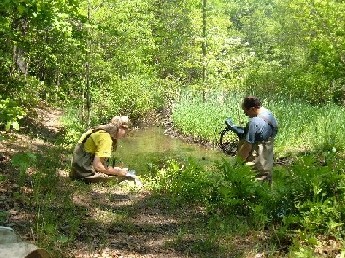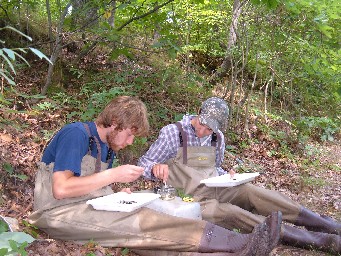Benthic Invertebrate Populations in the Muskegon Lake Area of Concern


Macroinvertebrate sampling along Ryerson Creek
Products:
Benthic Invertebrate Populations in the Muskegon Lake Area of Concern. [more]
Project Description:
AWRI conducted a benthic invertebrate monitoring program in Muskegon Lake and Ruddiman Creek that supported the PAC's efforts to delist the Degradation of Benthos BUI. The secondary goal was to communicate this information in an understandable manner to decision makers and stakeholder groups associated with the AOC. The sampling locations that we evaluated are shown in Figure 1. Fifteen locations in Muskegon Lake were sampled in triplicate during the fall of 2006 for benthic macroinvertebrates using a petite Ponar. These locations correspond to the stations used in 1999 (Carter 2002; Rediske et al. 2002) and also provide overlap with the investigation conducted in 1972 (Evans 1976). Benthic macroinvertebrates were enumerated and identified to genera/species level and analyzed by species diversity and trophic status metrics used previously (Carter 2002; Rediske et al. 2002). Sediment chemistry and toxicity were extensively examined at these locations in 1999. Due to the absence of significant anthropogenic inputs of toxic chemicals and the stability of sediments in large lakes, we assume that the sediments have similar quality and characteristics as in 1999. If significant changes in species composition or diversity are observed at any of the locations, an additional evaluation of sediment chemistry and toxicity would be required to determine the causative factors.
The benthic survey of Ruddiman Creek was conducted using upper Ryerson Creek as a reference site. The upper part of Ryerson Creek has similar land use, flow conditions, and has been impacted only by urban stormwater. During the summer of 2006 and 2007, invertebrates were sampled in Ruddiman Creek and Ryerson Creek. Triplicate macroinvertebrate samples were collected from representative vegetation types and analyzed according to methods described by Uzarski et al. (2004). Samples were collected from the same locations in the summer of 2005, prior to remediation, and preserved in ethanol. These samples, in addition to the 2006 and 2007 sample collections, were used to assemble a data set that includes macroinvertebrate populations indicative of pre and post remediation conditions.
